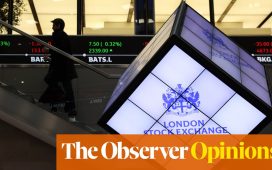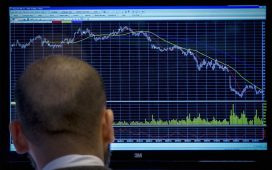Britain’s blue-chip share index has posted its biggest one-day jump of 2023 after US inflation slowed by more than expected last month.
The FTSE 100 index gained 133.5 points on Wednesday to 7,416 points, up 1.83%, its best day since November 2022.
Copper producer Antofagasta led the risers, jumping by 5.5%, followed mining giant Glencore (+4.87%), packaging firm Smurfit Kappa (+4.9%) and electrical products distributor RS Group (+4.5%).
Bank shares also rallied, after UK lenders passed this year’s Bank of England stress tests.
City traders were cheered by the news that US consumer prices rose by 3% in the year to June, the slowest inflation rate in more than two years, down from 4% in May.
As the dollar declined, the pound hit $1.30 for the first time since April 2022.
Easing US inflation figures lifted hopes that past increases in interest rates were succeeding in cooling prices. That could mean America’s central bankers may finally pause their increases in borrowing costs soon, easing fears that they would trigger a recession to fight inflation.
The drop in US inflation in June can largely be attributed to a fall in energy prices, which fell by 16.7% over the last year, with gas prices falling by 26.5%.
Annual core US inflation, which strips out food and energy, cooled to 4.8% from 5.3% in May. This measure is closely watched by policymakers.
Ronald Temple, chief market strategist at Lazard, said there was “nothing not to like” in the US inflation report.
“Shelter [housing] inflation decelerated as expected, services ex-shelter rose at less than a 2% annualised rate, and core goods prices were down due to slightly lower used-car prices that are likely to decline further through year-end,” Temple said.
“It’s too early to pop the champagne, but it’s not too early to start chilling the bottle,” Temple advised.
The US dollar fell by 1% to a 15-month low against a basket of currencies, on expectations that US interest rates could be near their peak.
George Saravelos, analyst at Deutsche Bank, said it was time to sell the dollar.
“First, we feel increasingly confident that the US disinflation process is well under way … Second, the disinflation process looks increasingly benign,” Saravelos said
The US Federal Reserve left interest rates on hold in June, after raising them 10 times in a row since March 2022. It meets again later this month, with some analysts suspecting it might make its final rise of the current cycle at its July meeting.
after newsletter promotion
“There’s no denying that at 3% June’s CPI number is the smallest year-on-year increase since March 2021 and that all-important core number also fell back significantly,” said Danni Hewson, head of financial analysis at AJ Bell.
“But despite the cautious optimism evident from market reaction it seems unlikely the Fed will be swayed enough to change course just yet.”
Analysts at ING said: “The Federal Reserve seems intent on pushing ahead with a July rate hike, but the need for additional tightening thereafter is questionable.”
According to CME Fedwatch, the Fed is likely to raise borrowing costs by 0.25 percentage points later this month, to a 5.25% to 5.5% range, but then leave them there for the rest of the year.
The Bank of England, though, is expected to raise interest rates from 5% to 6% by the end of 2023.
European stock markets also rallied, with Germany’s DAX and France’s CAC both up by about 1.5%. On Wall Street, the S&P 500 share index hit hits highest level since April 2022.
The FTSE 100 has had a volatile year. After hitting a record high of more than 8,000 points in February it has fallen back, and has lagged behind other main indices during 2023. The index has rallied back to where it began for 2023, while the S&P 500 has gained 16% this year.
Government bonds also recovered some of their recent losses, on hopes that inflation was being tamed in the US. This pulled down the yields, or interest rates, on short-term UK and US bonds, which hit 15-year highs last week.
“Today’s inflation numbers won’t have altered the calculus around [0.25 percentage points] US rate hike in two weeks’ time, however the direction of travel when it comes to the wider trend suggests it could be the last one in the current rate hiking cycle,” said Michael Hewson of CMC Markets. “It is this shift that markets are reacting to, with yields falling sharply in the US, as well as here in the UK.”
Inflation in the US is notably weaker than in Europe. Eurozone inflation is estimated to have dropped to 5.5% in June, while it was 8.7% in the UK in May, with June’s figures due next week.












